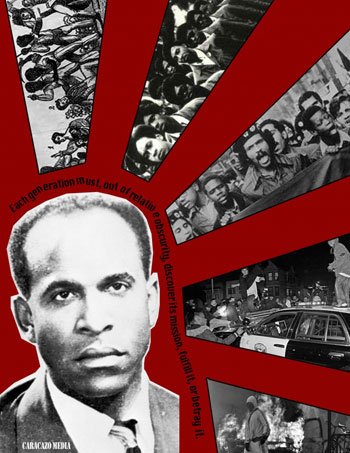After the disbanding of Bring the Ruckus, we promised a document that would say more about our organizational decision to disband. That decision was a difficult one, fraught with emotion. It was nothing, however, compared to the news of the death of our comrade and Ruckus founding member Joel Olson near the end of March. In the wake of this, an organizational reflection hardly seems to matter at all. What follows is a short tribute to our beloved comrade. It does not seek to be an obituary, or an accounting of his interests or accomplishments. We offer it here because this space still exists, at least for the time being. We offer it as a way to deal with the loss of a beloved comrade, which, despite the difficulty some of us had in the wake of our collective decision to disband, is 10,000 times harder -- or more -- to come to grips with.
Joel played an important role in the disbanding of an earlier organization, Love and Rage Revolutionary Anarchist Federation, as he and others argued strongly for the centrality of white supremacy as a primary obstacle to building a revolutionary anti-capitalist movement in the United States. After the split of Love and Rage, he helped found Phoenix Ruckus, a study group, but also one that put theory into practice, with the founding of Phoenix Copwatch. Phoenix Ruckus is ultimately what led to the founding of Bring the Ruckus in 2002 as a national revolutionary cadre organization, with a founding meeting in January 2004.
Joel’s founding status and relative experience compared to some of the BtR membership sometimes led folks to get the wrong idea. We joked at times that he was our “charismatic leader,” but other people, disposed to believing we were “Leninists,” “vanguardists” or who knows what, at times took this farther. Nothing could be less true about how Joel related to the organization as a whole and his comrades individually. He learned from everyone, and he was always open to listening to other viewpoints and changing his view on a situation. He always came prepared and ready to debate, yes, but ready to learn also. As a Repeal Coalition member said at Joel’s memorial service in April, he struggled alongside, never in front of. That was true of him in the streets and in meetings.
We formerly of Bring the Ruckus were all awaiting Joel’s return from Spain, to talk, debate, and perhaps build new structures or organizations more suited to the times we are in. It must be said here that one of the last things Joel did to have an effect on revolutionary organizing in the United States was to call in February for the disbanding of Bring the Ruckus. Although he loved its members and had done as much as anyone to build the organization and in so doing try to contribute to building a strong, revolutionary left pole, he believed Bring the Ruckus had ceased functioning in the way it needed to in order to have an effect on the revolutionary tendency and mass struggle in the United States. He believed that some relationships within the organization were so strained that they would pass a dangerous threshold if the organization stayed together. He and his longtime comrade and great friend Luis called for disbanding BtR in order to preserve these relationships. It must be said that they made the proposal along with their comrades from Flagstaff. It must also be said that they were not the only ones, or even the first ones, to believe that Ruckus had ceased functioning. After an emotional meeting in which we voted to disband despite many members' opposition or reservations, Joel commented to many of us about how principled we all were in coming to this decision, and how truly proud he was to be our comrades.
Thus, Joel’s last act as an American Revolutionary—and he truly was that—was to disband the organization he and others had begun. His legacy and contributions to North American anarchist and revolutionary politics cannot be questioned (to the point that, for instance, many young punks and anarchists are deeply influenced by him without even knowing it or of him). He furthered the cause of freedom both in theory and practice.
But we would all do well to remember how he acted, that for Joel it was never about his legacy or “his” organization. In true dialectical fashion, he proposed and then voted to dissolve what he had built, in order to build anew. He didn't know what that would be, and he wasn't absolutely certain that we made the right decision, but he was ready to see where it would go.
Joel Olson—Presente!!
We'll miss you, comrade, and are all proud to have struggled alongside you.
--by James Stephens
If you need to contact former members of Bring the Ruckus, please do so through James Stephens by sending an email to james.stephens919 [at] gmail.com.
Bring the Ruckus was disbanded by a majority vote of its members on Sunday, February 26th, 2012.
Many lessons can be drawn from our experience of more than a decade as a national revolutionary cadre organization, and a longer document will be forthcoming. Until then, please look for us in what we are doing rather than what we have done.
This site will be maintained for purposes of reference, but aside from reflections on our experience, no new posts will be appearing. If you need to contact former members of Bring the Ruckus, please do so via Joel Olson (olson.joel [at] gmail.com).
--The former National Committee of Bring the Ruckus
Next Saturday in Philadelphia, members of From Occupation to Liberation will lead a march to the 14th police district, as part of a continuing campaign against police brutality. Their campaign began last fall, when cops brutalized local resident Florence Mason and her family in the course of executing an illegal eviction.
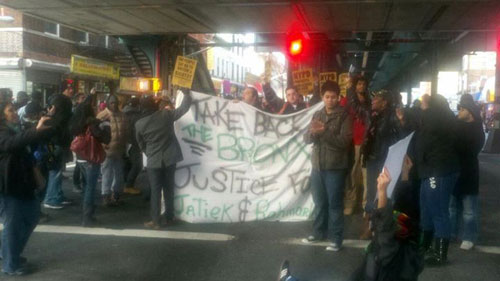
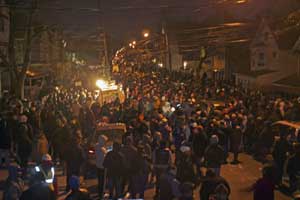
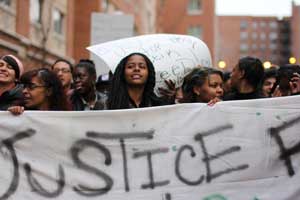
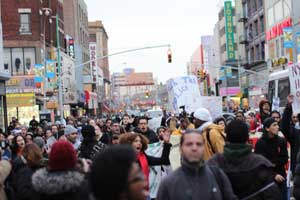
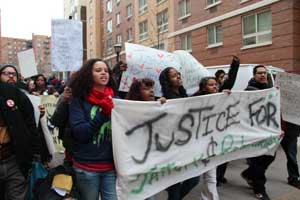
In the Bronx, a recent wave of police violence has prompted a string of mobilizations in different parts of the borough.
On January 26th, cops approached 19-year-old Jateik Reed while he was hanging on his block with his friends, and proceeded to beat him viciously with fists and clubs. The incident was caught on video by one of Jateik's friends, who was chased down the block as officers threatened to mace him. Jateik was booked on false charges, and when his parents went to the local precinct to demand information, they too were arrested and charged with "disorderly conduct."
Video of the incident hit the internet just days after a the Stop Stop & Frisk campaign held a march to the same precinct where the officers who beat Jateik were stationed. Take Back the Bronx (formerly Occupy the Bronx) and members of Bring the Ruckus followed Jateik's case in the days following, fielding people to court support and organizing a march through the South Bronx against police violence. But even before the action could take place, cops shot and killed an unarmed black youth sixty blocks to the north.
On February 2nd, narcotics officers murdered 18-year-old Ramarley Graham in his own home, after entering through a backdoor while not in hot pursuit. Graham was gunned him down in front of his grandmother and little brother in his bathroom, as he frantically attempted to flush a bag of weed. Response to Graham's murder was swift and furious, including a rally the night of the murder organized by the Stop Stop & Frisk campaign, and another large rally in the days following. Two marches organized by Take Back the Bronx followed this chain of events, with videos below.
The first march in the South Bronx piggybacked off a press conference called by local politicians. Participants hit the 42nd precinct, took the streets and blocked a 6-way intersection in a commercial center, blocked cop cars at a nearby public housing police station, and closed with a rally on Jateik Reed's block with his friends and family.
In the days following, Jateik's family secured the head of the National Lawyer's Guild as their legal representation, gathered donations to bail him out of Rikers, and are now calling for a special investigator to look into his case.
A second march took place the following weekend in Ramarley Graham's neighborhood. Participants held a roving speakout which again took the streets, blocked intersections, confronted officers from the 47th precinct, and closed with a moment of silence outside Graham's home with his family.
Here is a short video by Occupy Our Homes Chicago, documenting the foreclosure canvassing led by the Chicago Anti-Eviction Campaign over the Dr. Martin Luther King, Jr. Holiday.
The following piece, written by a comrade in Philadelphia and originally posted on CounterPunch, describes the counterinsurgency campaign currently underway against the Occupy movement in Oakland.
Coercive Attrition and the Occupy Movement
by George Ciccariello-Maher
As winter sets in, the Occupy Movement nationwide confronts a new series of challenges. Conspiring with the weather, however, is the threat of a shifting policing model currently being tested out in Oakland.
Coercive Attrition
The Italian Communist Antonio Gramsci spoke of a distinction between “war of position” and “war of maneuver,” between those gradual and occasionally imperceptible political struggles that occur every day and the frontal attack on power toward which they eventually build. While this distinction is necessary, it should not be overstated, and nor can we associate the war of position too directly with ideological struggle and war of maneuver with direct military attacks on and by the coercive apparatus of the state. Recent events in Oakland and the strategy of coercive attrition directed against the Occupy Movement make perfectly clear just how insufficient such a correlation would be.
Recent weeks have seen the Occupy Movement confronted with a war of attrition nationwide: as cold weather sets in, many cities have opted to wait out the movement, allowing excitement to fade and the movement to devour itself in the petty squabbles of disempowerment. Often, though, this strategy of passive attrition operates alongside a more aggressive approach. In Philadelphia, for example, a hands-off approach to the now-decamped Occupy Philly operates in tandem with ferocity toward those who step out of line in a transparent attempt to bully radicals into submission (as with the case of two housing activists currently facing multiple felonies).
But it is in Oakland more than anywhere else that friendly weather and sustained militancy have given rise to a different approach, one similarly premised on chipping away at the movement through attrition and fatigue but doing so in a far more repressive manner. One key ingredient to this peculiar constellation of forces is the empty vessel perched atop the city government: Mayor Jean Quan. Quan was discredited long ago and from all sides, hated by the left for unleashing the near fatal attacks on Occupy Oakland in October, and by the right (represented by OPD and the City Council) for not taking a harder line. Now, having opted to vacillate rather than stand on the side of history, she will simply be hoping to serve out her term and avoid an embarrassing recall campaign.
This vacillation has been nowhere clearer than on the question of the epic Port Shutdowns on November 2nd and December 12th, the first of which catapulted Occupy Oakland to the forefront of the national movement, and the second of which demonstrated a capacity for coordinated militancy not seen in this country for decades at least. Since it was Quan who took the heat for the unrestrained actions of police in October, one could hardly blame the Mayor for hesitating to unleash OPD and other forces against those blocking the port. But when Quan suggested that the city might not be able to prevent future shutdowns of the port, her critics in City Council found powerful echo in Governor Jerry Brown. But for now at least, OPD’s hands are at least partially tied, an the full-on assaults of many an officer’s dream go unfulfilled for now.
Blocked from engaging in a brutal war of maneuver, OPD’s strategy has been a different one, and what remains of Occupy Oakland’s presence in Oscar Grant Plaza has seen small raids with a handful of arrests several times a week. While some interpret this half-heartedness by the forces of order as a sign of impotence, the frequency, the timing, and the serious charges incurred in the raids speak to a more sinister strategy.
The following theoretical work by Arturo, a member of BtR-Philly, examines the concepts of praxis, spontaneity, cadre and humanity in the work of revolutionary thinker Frantz Fanon. It is accompanied by a piece of visual art by Lainie, a member of BtR-NYC, which places Fanon within a historical trajectory of mass struggle from colonization to the present.
Down a New Road:
Thoughts on Fanon’s Revolutionary Praxis
By Arturo
What I call middle-class society is any society that becomes rigidified in predetermined forms, forbidding all evolution, all gains, all progress, all discovery…a closed society in which life has no taste.
—Fanon, Black Skin White Masks
Revolution is necessary, therefore, not only because the ruling class cannot be overthrown in any other way, but also because the class overthrowing it can only in a revolution succeed in ridding itself of all the muck of ages and become fitted to found society anew.
—Marx and Engels, The German Ideology
Initially subjective, the breaches made in colonialism are the result of a victory of the colonized over their old fear and over the atmosphere of despair distilled day after day by a colonialism that has incrusted itself with the prospect of enduring forever.
—Fanon, A Dying Colonialism
That people change at the same time that they change the world is a basic fact of revolutionary praxis. In the very moment of lashing out against an insuperable oppression the individual undergoes a radical alteration. Frantz Fanon took this observation a step further in arguing that at the very center of the individual participating in social change is not only a “remodeling” of the consciousness we have of ourselves, or the ruling class and its world, “at last within reach”—there is also a “renewal” of the “symbols, the myths, the beliefs, the emotional responsiveness of the people,” in short, the “reassertion” of our “capacity to progress.”1 This intersection of thought and practice is the critical focus of Fanon’s dialectical conception of revolutionary praxis. A common theme in his theoretical work, a theme fiercely developed by Fanon scholar Lewis Gordon, is that of human consciousness as an open-ended question, as a lived experience of the body in movement, in antagonism with the inhuman institutions of society. This consideration stimulates the question: how and why does revolutionary thought arise in the process of battle for a new humanity?
True to the nature of his ideas, to read Fanon’s writings is to engage in a continual process of methodological self-reflection. One finds oneself going back to the texts at an unusual frequency, discovering new ways of interpretation. To start off with, if one is to study Fanon’s conception of revolutionary praxis, one must begin with the basic thesis that the human is a perpetual question—that “basic personality” is not “a constant,” but rather “a variable.”2 V.I. Lenin and other communist philosophers have somewhat of a similar existential tendency in this regard. Lenin wrote in Guerrilla Warfare “new forms of struggle, unknown to the participants of the given period, inevitably arise as the given social situation changes…the coming crises will introduce new forms of struggle that we are now unable to foresee.” In other words, revolutionary praxis is never a fixed dogma. It is born out of the changing circumstances of the historical space and the political time of each revolutionary situation. That is another thesis of Fanon’s, which overlaps with a similar tradition in C.L.R. James and Gordon: that a people cannot know in advance what forms of organization and methods of struggle their liberation will take, for to attempt to do so is to impose bureaucratic abstractions on a living, breathing phenomenon. Marx also reflected this current when he declared that “I am not going to write any recipes for the cook shops of the future.” In revolution there is never the guarantee of a future heaven and always the risk of failure.
Let’s look at some examples of how this revolutionary praxis plays out. Fanon highlights in A Dying Colonialism how the possibility of a new horizon not previously imaginable emerges in periods of revolutionary upsurge. In his essay “Algeria Unveiled” Fanon details the transformation of the Algerian woman who participates in the national liberation struggle, an involvement that necessitates a radical reorganization and reexamination of the familial structure of Algerian society. “The old fear of dishonor was swept away by a new fear, fresh and cold—that of death in battle or torture of the girl. Behind the girl, the whole family—even the Algerian father, the authority for all things, the founder of every value—following in her footsteps, becomes committed to the new Algeria.”3 Hierarchal customs, fixed relics of the past, flexibly adjusted themselves to new conditions as they arose. The veil, a symbol of sexual subordination, became an instrument of female rebellion, a means to sneak weapons past the French military. Defying all tradition, the veil was taken off—Algerian women Europeanized themselves in order to further deceive the enemy. In the Algerian woman was the birth of a completely new consciousness, “without preliminary instruction,” without a previously known “character to imitate.”4
A similar methodological shift is detailed in “This Is the Voice of Algeria” and in “Medicine and Colonialism.” Fanon explains how the radio and medicine of Europeans were at first rejected by Algerians, just as attempts by Europeans to unveil the Algerian woman were rejected, not because of backwardness, but because they were techniques solely in the hands of the occupiers, which threatened to annihilate Algerian national consciousness. To preserve from foreign intrusion ones basic personality, ones native consciousness of the world, even if metaphysically, was more important than finding a common ground with the enemy. Moreover, new forms of resistance beyond the old ones were made possible through the conservation of traditional values in the face of the interruption of colonialism. In the midst of racial domination and repression Algerians preserved their national consciousness while imaginatively recreating it. Fanon goes on to show how techniques of colonialism were expropriated by the colonized, the radio and medicine rapidly adopted by Algerians in the war of independence and used in completely new ways, synthesized with traditional constructions of reality, transforming instruments of colonial oppression into those of native liberation. The necessities of combat against French colonialism forced the “dislocation of old myths,” giving rise to “new attitudes, to new modes of action, to new ways,” in short, to a new praxis.5
Fanon highlights how these kinds of revolutionary modifications cannot fit neatly into objective or quantitative frameworks; shifts of praxis cannot be calculated as mathematical equations are calculated. “At the level of actual experience, one cannot expect to obtain a rationalization of attitudes and choices.”6 The subjective reasoning of the colonized in choosing to reject the techniques of the colonizers in order to safeguard their native ideas and practices, when objectively, in cold rationality, these foreign techniques could have benefited them, and then taking the techniques up in the course of the revolution—the reasons for this cannot be inventoried. They are situated within a particular experience of reality.
Today in Oakland, a march and rally commemorated the third anniversary of the police murder of Oscar Grant. Sponsored by the Oscar Grant Committee, Occupy Oakland and Bring the Ruckus, the action was one of several memorial and solidarity events held across the country. Below is a poster from the action, and a youtube video from Decolonize Portland.
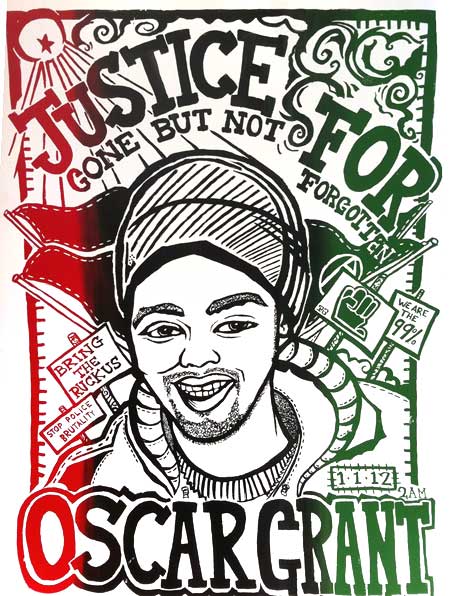
The following piece was written by revolutionaries in the NYC area just before the December 12th actions on the west coast, in order to call for a meeting of a specifically anti-capitalist current emerging from Occupy Wall Street. It was originally posted on Insurgent Notes, and we syndicate it here in the interest of furthering the formation of a revolutionary tendency within the Occupy movement. For more information, contact the original authors of the statement at: againstprofitnyc [at] gmail.com.
A Call to an Open Meeting
January 8, 2012
6:00 PM – 8:00 PM
The Commons
388 Atlantic Avenue in Brooklyn
(three blocks from the Atlantic Avenue Subway Stop)
We write on the day before Occupy protesters will be acting up and down the Pacific Coast to blockade the ports. We pledge our solidarity with them and look forward to hearing of their success. The strategy of a port shutdown hints at the recognition that the future of the Occupy movement requires the development of a clear and powerful anti-capitalist current. We believe that the time has come to place the development of an organizational expression of such a current on the agenda of New York activists. We therefore are inviting all those interested to an initial meeting on January 8th at the location above. There will be several brief presentations but plenty of time for discussion. What follows is a preliminary exploration of a number of the issues that we see as pressing. We look forward to hearing your reactions and your ideas.
Issued by: a group of anti-capitalist activists on December 12, 2012
For more information on some of those involved, write to: againstprofitnyc [at] gmail.com
The 1% of the 99%
A statement on the role of trade unions and
workers’ activity in the “occupy movement”
For distribution Dec. 12 2012 and beyond
In the current economic and social crisis, the ability for workers to effectively make gains through the structures of our unions is almost non-existent. In fact, for the past two months of the occupation movement here in the United States, union leaders have either scrambled to play catch-up with the social needs of the working class, undermined the movement’s grassroots efforts at contesting these attacks by moving to the right of them, or acted its own policing force against not only its official members, but political activity in general.
But if we look historically, these union strategies are consistent with their historical role within capitalist society as the mediation between management and workers. The primary activity of the trade union—through the means of a group of people in leadership positions, or the bureaucracy–is to negotiate a contract for the benefits, wages, and (sometimes) specific working conditions of labor in their exploitative relation with their employers. In order to accomplish this, they operate as an organization over and above rank and file workers in order to maintain an exclusive and specialized relationship with management, thereby perpetuating a relationship of dominance over their members despite occasionally, and partially, allowing them to express their dissent. In fact, this dissent can help negotiations as well: “If you don’t promise X, Y, or Z, we cannot be held responsible for what these crazy workers might do! However, if you do promise [which doesn’t mean carry out] we can most likely keep them working productively for you.” Additionally, and within the context of the current crisis, trade unions are able to achieve less and less, and as a result, the rank and file are left without any means to struggle through the union. And because the results of negotiations which, for example, bargained away the “right” to strike, are carried forward into a time when it is structurally impossible for capitalism to make concessions, struggles beyond bureaucracy are more and more of a necessity. To hope that the union bureaucracy will respond to the needs of the working class is to circumscribe hope as the leash of submission.
This position does not come from the individual politics of trade union bureaucrats themselves, from their personalities, or even from a particular caucus that has leadership. It is instead the historical role of unions as the mediators between labor, that is, the workers who produce the profit, goods, education, etc. for society as a whole, and capital. The union bureaucracy cannot imagine a world without capitalism, because their existence is predicated upon negotiations within its mechanisms and enforcements.
If we look at the activities of the unions in New York over the last month alone, for example, we can see this clearly. For many of those involved in the occupation movement, who have remarked that Occupy Wall Street itself has shifted the unions towards a more left position, there is a surprise when the first signs militancy within the protests brings with it derailment as the union leaders transform the anger of the working class into platforms for the Democratic Party. Let us take a closer look at some recent events.
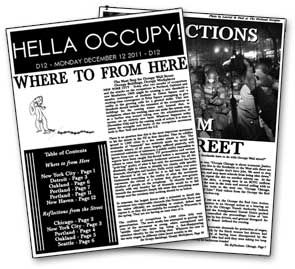 A group of revolutionaries from across the country, including members of Bring the Ruckus, the May First Anarchist Alliance, Black Orchid Collective, and others, have assembled a pamphlet that includes reports and analysis from the Occupy movement.
A group of revolutionaries from across the country, including members of Bring the Ruckus, the May First Anarchist Alliance, Black Orchid Collective, and others, have assembled a pamphlet that includes reports and analysis from the Occupy movement.
Released in sync with the West Coast Port Shutdown on December 12th, the pamphlet features "Reports from the streets" from five cities across the country, and analysis from multiple perspectives that ask "Where to from here?". It is available for viewing and download onScribd.
We have included one selection from the pamphlet below, originally posted on Insurgent Notes.
Today, after two months of occupations and the attacks on the occupations in Portland, Oakland and now Manhattan, OWS might be crossing a new threshold–a massive convergence of students in Union Square and a working-class convergence in Foley Square attempting to give reality to the growing calls for a general strike. That new threshold should include the extension of the occupations to buildings for the coming winter and, beyond that, to workplaces, where the working class can make the system stop, as a further step toward taking over the administration of society on an entirely new basis. Whatever happens today (November 17th) and in the coming week of action, it is time to assess the strengths and limits of the occupation movement both in New York and around the U.S.
There is no question that this is the most important movement to hit the streets in the US in four decades. Its wildfire spread to 1,000 cities in a few weeks attests to that. The avalanche of “demands” has suddenly made the social and economic misery of 40 years, largely suffered passively, with occasional outbursts of resistance, a public reality impossible to ignore from now on. Politicians, TV personalities and various experts have been caught flat-footed before a movement that refuses to enter their suddenly irrelevant universe. For all the “grab-bag” quality of what it has said, the movement has been absolutely right to refuse to identify too closely with specific demands, ideologies and leaders. Daily social reality over years has educated it all too well for it to fall into that game. Underneath everything is the reality of what the movement represents: the refusal of a society that places ever-greater numbers of people on the scrapheap. To identify itself too closely with any laundry list of demands would be to fall beneath the movement’s deeply felt sense that everything must change and the certainty that nothing should be as before.
